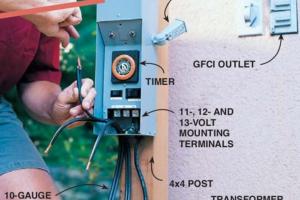Ultimate Guide: How to Install Low Voltage Lighting for Your Home

-
Quick Links:
- Introduction
- Benefits of Low Voltage Lighting
- Planning Your Lighting Installation
- Tools and Materials Needed
- Step-by-Step Installation Process
- Maintenance Tips
- Case Studies and Examples
- Expert Insights
- FAQs
Introduction
Low voltage lighting is a fantastic option for homeowners looking to enhance their outdoor spaces. This guide will walk you through everything you need to know to install low voltage lighting yourself, saving you both time and money.
Benefits of Low Voltage Lighting
Low voltage lighting comes with several advantages:
- Energy Efficiency: Uses less electricity compared to traditional lighting.
- Safety: Lower voltage reduces the risk of electrical shock.
- Versatility: Ideal for various applications, from landscape lighting to pathway illumination.
- Aesthetic Appeal: Enhances the beauty of your outdoor spaces.
Planning Your Lighting Installation
Before you begin, it is crucial to plan out your lighting design:
- Identify areas to illuminate, such as pathways, gardens, and patios.
- Choose the right style of fixtures for your home’s architecture.
- Consider the placement of power sources and wiring.
- Create a lighting layout diagram to visualize your installation.
Tools and Materials Needed
Gather the following tools and materials:
- Low voltage transformer
- Low voltage lighting fixtures
- Wire (12- or 14-gauge)
- Wire connectors
- Spade connectors
- Wire strippers
- Shovel or trenching tool
- Voltage tester
Step-by-Step Installation Process
Step 1: Turn Off Power
Ensure the power is off at the main breaker box before starting your installation.
Step 2: Install the Transformer
Mount the transformer near a power source, following the manufacturer's instructions.
Step 3: Lay Out the Wiring
Run the low voltage wire from the transformer to the locations of your fixtures. Use a shovel to create a trench for the wire if necessary.
Step 4: Connect the Fixtures
Attach the fixtures to the wiring using wire connectors. Ensure all connections are tight and secure.
Step 5: Test the System
Once all connections are made, turn the power back on and test each fixture to ensure they are working correctly.
Maintenance Tips
To keep your low voltage lighting in optimal condition:
- Regularly check connections for corrosion or damage.
- Clean fixtures to maintain brightness.
- Inspect wiring for wear and tear.
Case Studies and Examples
Consider the following examples of successful low voltage lighting installations:
Example 1: Residential Garden
A homeowner installed low voltage lights in their garden to highlight flower beds and trees, resulting in a beautiful night-time landscape.
Example 2: Pathway Illumination
By illuminating pathways with low voltage lighting, a homeowner improved safety and aesthetics, making their outdoor space more inviting.
Expert Insights
Experts recommend considering LED fixtures for low voltage lighting due to their long lifespan and energy efficiency. Additionally, they suggest planning your layout during the daytime for better visibility of potential issues.
FAQs
1. What is low voltage lighting?
Low voltage lighting uses a transformer to reduce the voltage of the electrical supply, typically using 12V or 24V, making it safer and more energy-efficient.
2. Can I install low voltage lighting myself?
Yes, with the right tools and materials, DIY installation is possible and can save you on labor costs.
3. How much does low voltage lighting cost?
The cost can vary widely based on the number of fixtures and the complexity of the installation, but it generally ranges from $100 to $500 for a typical setup.
4. Do I need a permit to install low voltage lighting?
Typically, low voltage lighting does not require a permit, but it’s always best to check with local regulations.
5. How long does low voltage lighting last?
With proper maintenance, low voltage lighting fixtures can last up to 20 years, especially if LED bulbs are used.
6. Can I use low voltage lighting indoors?
Yes, low voltage lighting can be used indoors, particularly in areas where traditional lighting may be unsafe.
7. What type of bulb should I use?
LED bulbs are highly recommended for their efficiency and longevity.
8. How many fixtures can I connect to one transformer?
This depends on the transformer’s wattage and the total wattage of all connected fixtures. Always check the specifications.
9. What maintenance is required for low voltage lighting?
Regularly check connections, clean fixtures, and inspect wiring for any signs of damage.
10. Is low voltage lighting safe?
Yes, low voltage lighting is considered very safe, as the reduced voltage minimizes the risk of electrical shock.
By following this comprehensive guide, you can successfully install low voltage lighting that enhances your outdoor space while being energy-efficient and safe.
References
- Energy Saver - Outdoor Lighting
- Lighting Design Lab - Low Voltage Lighting
- Home Depot - Low Voltage Outdoor Lighting
- ACEEE - Energy Efficiency Research
- Green Building Advisor - Installing Low Voltage Landscape Lighting
Random Reads